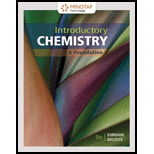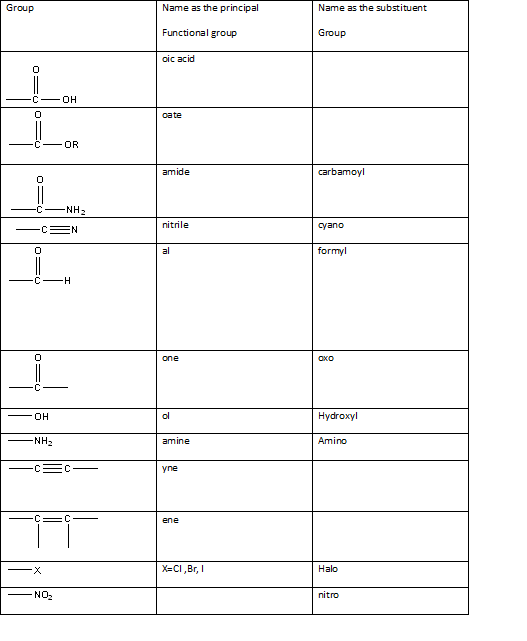
Introductory Chemistry
9th Edition
ISBN: 9781337399524
Author: Steven S. Zumdahl, Donald J. DeCoste
Publisher: Cengage Learning
expand_more
expand_more
format_list_bulleted
Concept explainers
Question
Chapter 20, Problem 53QAP
Interpretation Introduction
Interpretation:
The question asks how the relative locations of the substituents are identified when a benzene ring has several substituents.
Concept Introduction:
- The International Union of Pure and Applied Chemistry-IUPAC has developed a method for systematically naming organic compounds.
- The name given to a compound according to the
IUPAC nomenclature consists of several parts. - The suffix that is used to indicate the main functional group of the structure.
- Name of the chain that is used to identify the main carbon chain of the compound.
- The prefixes that are used to indicate the substituent groups.
- The numbers that are used to indicate the places at which the substituent groups, additional groups and the main
functional groups are attached to the chain.

Table 1: The series of functional groups arranged in the decreasing order of the priority
| Number of carbon atoms | Root name | Name of the corresponding Hydrocarbon |
| 1 | meth | Methane |
| 2 | eth | Ethane |
| 3 | prop | Propane |
| 4 | but | Butane |
| 5 | pent | Pentane |
| 6 | hex | Hexane |
Table 2: The root names used for the compounds according to the number of carbon atoms and the names of the corresponding hydrocarbons.
Expert Solution & Answer
Want to see the full answer?
Check out a sample textbook solution
Students have asked these similar questions
How many hydrogen atoms are connected to the indicated carbon atom?
Identify the compound with the longest carbon - nitrogen bond.
O CH3CH2CH=NH
O CH3CH2NH2
CH3CH2C=N
CH3CH=NCH 3
The length of all the carbon-nitrogen bonds are the same
Identify any polar covalent bonds in epichlorohydrin with S+ and 8- symbols in the appropriate locations. Choose the correct answer
below.
Η
H's+
6Η Η
Η
Η
Η
Ηδ
Η
Ο
Ο
HH
+Η Η
+Η Η
Η
-8+
CI
Chapter 20 Solutions
Introductory Chemistry
Ch. 20.2 - Exercise 20.1 Give the molecular formulas for the...Ch. 20.4 - Exercise 20.2 Name the following molecules. a. b.Ch. 20.4 - Exercise 20.3 Write the structural formula for...Ch. 20.5 - Petroleum is a very valuable raw material for the...Ch. 20.7 - Exercise 20.4 Name the following molecules. a. b.Ch. 20.9 - Prob. 20.5SCCh. 20.11 - Prob. 20.6SCCh. 20.14 - Prob. 20.7SCCh. 20 - What is meant by the term “unsaturated...Ch. 20 - Prob. 2ALQ
Ch. 20 - Prob. 3ALQCh. 20 - How many different possible “tetramethylbenzenes”...Ch. 20 - For the general formula C6H14O, draw the...Ch. 20 - Prob. 6ALQCh. 20 - Prob. 1QAPCh. 20 - Your roommate, a chemistry major, claims to have...Ch. 20 - Prob. 3QAPCh. 20 - How many electron pairs are shared when a triple...Ch. 20 - Prob. 5QAPCh. 20 - Prob. 6QAPCh. 20 - Prob. 7QAPCh. 20 - Prob. 8QAPCh. 20 - Prob. 9QAPCh. 20 - . The chains in normal alkanes are not really...Ch. 20 - Prob. 11QAPCh. 20 - Prob. 12QAPCh. 20 - . Give the name of each of the following...Ch. 20 - Prob. 14QAPCh. 20 - . What are structural isomers? Which is the...Ch. 20 - Prob. 16QAPCh. 20 - Prob. 17QAPCh. 20 - Prob. 18QAPCh. 20 - Prob. 19QAPCh. 20 - Prob. 20QAPCh. 20 - . What is an alkyl group? How is a given alkyl...Ch. 20 - . When naming alkanes, find the longest continuous...Ch. 20 - Prob. 23QAPCh. 20 - . When naming alkanes, the alkyl groups are listed...Ch. 20 - . Give the systematic name for each of the...Ch. 20 - . Give the systematic name for each of the...Ch. 20 - Prob. 27QAPCh. 20 - Prob. 28QAPCh. 20 - Prob. 29QAPCh. 20 - Prob. 30QAPCh. 20 - . What is pyrolytic cracking, and why is the...Ch. 20 - Prob. 32QAPCh. 20 - . Explain why alkanes are relatively unreactive.Ch. 20 - Prob. 34QAPCh. 20 - . Indicate the missing molecule in each of the...Ch. 20 - Prob. 36QAPCh. 20 - Prob. 37QAPCh. 20 - Prob. 38QAPCh. 20 - Prob. 39QAPCh. 20 - Prob. 40QAPCh. 20 - Prob. 41QAPCh. 20 - Prob. 42QAPCh. 20 - Prob. 43QAPCh. 20 - Prob. 44QAPCh. 20 - Prob. 45QAPCh. 20 - Prob. 46QAPCh. 20 - Prob. 47QAPCh. 20 - Prob. 48QAPCh. 20 - Prob. 49QAPCh. 20 - . Benzene exhibits resonance Explain this...Ch. 20 - . How is a monosubstituted benzene named? Give the...Ch. 20 - Prob. 52QAPCh. 20 - Prob. 53QAPCh. 20 - . What do the prefixes ortho-, meta-, and para-...Ch. 20 - Prob. 55QAPCh. 20 - Prob. 56QAPCh. 20 - Prob. 57QAPCh. 20 - Prob. 58QAPCh. 20 - . What functional group characterizes an alcohol?...Ch. 20 - Prob. 60QAPCh. 20 - . Give the systematic name for each of the...Ch. 20 - . Is 1-pentanol a primary, secondary, or tertiary...Ch. 20 - . Why is methanol sometimes called wood alcohol?...Ch. 20 - Prob. 64QAPCh. 20 - . Write the equation for the synthesis of ethanol...Ch. 20 - . What is the simplest aromatic alcohol commonly...Ch. 20 - Prob. 67QAPCh. 20 - Prob. 68QAPCh. 20 - Prob. 69QAPCh. 20 - Prob. 70QAPCh. 20 - Prob. 71QAPCh. 20 - Prob. 72QAPCh. 20 - Prob. 73QAPCh. 20 - Prob. 74QAPCh. 20 - Prob. 75QAPCh. 20 - Prob. 76QAPCh. 20 - Prob. 77QAPCh. 20 - Prob. 78QAPCh. 20 - Prob. 79QAPCh. 20 - Prob. 80QAPCh. 20 - Prob. 81QAPCh. 20 - . Draw a structural formula for each of the...Ch. 20 - Prob. 83QAPCh. 20 - Prob. 84QAPCh. 20 - Prob. 85QAPCh. 20 - Prob. 86QAPCh. 20 - Prob. 87QAPCh. 20 - Prob. 88QAPCh. 20 - Prob. 89APCh. 20 - Prob. 90APCh. 20 - Prob. 91APCh. 20 - Prob. 92APCh. 20 - Prob. 93APCh. 20 - . The systematic names of all saturated...Ch. 20 - Prob. 95APCh. 20 - Prob. 96APCh. 20 - Prob. 97APCh. 20 - Prob. 98APCh. 20 - Prob. 99APCh. 20 - . With very reactive agents, such as the halogen...Ch. 20 - . Alkenes and alkynes are characterized by their...Ch. 20 - Prob. 102APCh. 20 - Prob. 103APCh. 20 - Prob. 104APCh. 20 - Prob. 105APCh. 20 - Prob. 106APCh. 20 - Prob. 107APCh. 20 - Prob. 108APCh. 20 - Prob. 109APCh. 20 - Prob. 110APCh. 20 - Prob. 111APCh. 20 - Prob. 112APCh. 20 - Prob. 113APCh. 20 - Prob. 114APCh. 20 - Prob. 115APCh. 20 - . Give the systematic name for each of the...Ch. 20 - Prob. 117APCh. 20 - Prob. 118APCh. 20 - Prob. 119APCh. 20 - Prob. 120APCh. 20 - Prob. 121APCh. 20 - Prob. 122APCh. 20 - Prob. 123APCh. 20 - Prob. 124APCh. 20 - Prob. 125APCh. 20 - Prob. 126APCh. 20 - Prob. 127APCh. 20 - Prob. 128APCh. 20 - Prob. 129APCh. 20 - Prob. 130APCh. 20 - Prob. 131APCh. 20 - . Write the formula for the missing reactant or...Ch. 20 - Prob. 133APCh. 20 - Prob. 134APCh. 20 - . Name each of the following aromatic or...Ch. 20 - Prob. 136APCh. 20 - Prob. 137APCh. 20 - Prob. 138APCh. 20 - Prob. 139APCh. 20 - Prob. 140APCh. 20 - Prob. 141APCh. 20 - . Name each of the following alkanes....Ch. 20 - Prob. 143CPCh. 20 - Prob. 144CPCh. 20 - Prob. 145CPCh. 20 - Prob. 146CPCh. 20 - Prob. 147CP
Knowledge Booster
Learn more about
Need a deep-dive on the concept behind this application? Look no further. Learn more about this topic, chemistry and related others by exploring similar questions and additional content below.Similar questions
- H H:O::::H H H HH H::O:D:D:H HH HH H:O:D:D:H .. HH H:O:D:D:H H H Select the correct Lewis dot structure for the following compound: CH3CH2OHarrow_forwardRank the following compounds in order of decreasing boiling point. ннннн -С-С-Н . н-с- ННННН H ΗΤΗ НННН TTTĪ н-с-с-с-с-о-н НННН НН C' Н н-с-с-с-с-н НН || Ш НННН H-C-C-C-C-N-H ННННН IVarrow_forwardRank the following compounds in order of decreasing dipole moment. |>||>||| ||>|||>| |>|||>|| |||>||>| O ||>>||| H F H F H c=c || H c=c F F IIIarrow_forward
- choose the description that best describes the geometry for the following charged species ch3-arrow_forwardWhy isn't the ketone in this compound converted to an acetal or hemiacetal by the alcohol and acid?arrow_forwardWhat is the approximate bond angle around the nitrogen atom? HNH H Harrow_forward
- OH 1. NaOCH2CH3 Q 2. CH3CH2Br (1 equiv) H3O+ Select to Draw 1. NaOCH2 CH3 2. CH3Br (1 equiv) heat Select to Edit Select to Drawarrow_forwardComplete and balance the following half-reaction in acidic solution. Be sure to include the proper phases for all species within the reaction. S₂O₃²⁻(aq) → S₄O₆²⁻(aq)arrow_forwardQ Select to Edit NH3 (CH3)2CHCI (1 equiv) AICI 3 Select to Draw cat. H2SO4 SO3 (1 equiv) HO SOCl2 pyridine Select to Edit >arrow_forward
- Complete and balance the following half-reaction in basic solution. Be sure to include the proper phases for all species within the reaction. Zn(s) → Zn(OH)₄²⁻(aq)arrow_forwardb. ὋΗ CH3CH2OH H2SO4arrow_forwardFor the reaction A (g) → 3 B (g), Kp = 0.379 at 298 K. What is the value of ∆G for this reaction at 298 K when the partial pressures of A and B are 5.70 atm and 0.250 atm?arrow_forward
arrow_back_ios
SEE MORE QUESTIONS
arrow_forward_ios
Recommended textbooks for you
 World of Chemistry, 3rd editionChemistryISBN:9781133109655Author:Steven S. Zumdahl, Susan L. Zumdahl, Donald J. DeCostePublisher:Brooks / Cole / Cengage Learning
World of Chemistry, 3rd editionChemistryISBN:9781133109655Author:Steven S. Zumdahl, Susan L. Zumdahl, Donald J. DeCostePublisher:Brooks / Cole / Cengage Learning Introductory Chemistry: A FoundationChemistryISBN:9781337399425Author:Steven S. Zumdahl, Donald J. DeCostePublisher:Cengage LearningChemistry: Matter and ChangeChemistryISBN:9780078746376Author:Dinah Zike, Laurel Dingrando, Nicholas Hainen, Cheryl WistromPublisher:Glencoe/McGraw-Hill School Pub Co
Introductory Chemistry: A FoundationChemistryISBN:9781337399425Author:Steven S. Zumdahl, Donald J. DeCostePublisher:Cengage LearningChemistry: Matter and ChangeChemistryISBN:9780078746376Author:Dinah Zike, Laurel Dingrando, Nicholas Hainen, Cheryl WistromPublisher:Glencoe/McGraw-Hill School Pub Co ChemistryChemistryISBN:9781305957404Author:Steven S. Zumdahl, Susan A. Zumdahl, Donald J. DeCostePublisher:Cengage Learning
ChemistryChemistryISBN:9781305957404Author:Steven S. Zumdahl, Susan A. Zumdahl, Donald J. DeCostePublisher:Cengage Learning Chemistry: An Atoms First ApproachChemistryISBN:9781305079243Author:Steven S. Zumdahl, Susan A. ZumdahlPublisher:Cengage Learning
Chemistry: An Atoms First ApproachChemistryISBN:9781305079243Author:Steven S. Zumdahl, Susan A. ZumdahlPublisher:Cengage Learning

World of Chemistry, 3rd edition
Chemistry
ISBN:9781133109655
Author:Steven S. Zumdahl, Susan L. Zumdahl, Donald J. DeCoste
Publisher:Brooks / Cole / Cengage Learning

Introductory Chemistry: A Foundation
Chemistry
ISBN:9781337399425
Author:Steven S. Zumdahl, Donald J. DeCoste
Publisher:Cengage Learning

Chemistry: Matter and Change
Chemistry
ISBN:9780078746376
Author:Dinah Zike, Laurel Dingrando, Nicholas Hainen, Cheryl Wistrom
Publisher:Glencoe/McGraw-Hill School Pub Co

Chemistry
Chemistry
ISBN:9781305957404
Author:Steven S. Zumdahl, Susan A. Zumdahl, Donald J. DeCoste
Publisher:Cengage Learning

Chemistry: An Atoms First Approach
Chemistry
ISBN:9781305079243
Author:Steven S. Zumdahl, Susan A. Zumdahl
Publisher:Cengage Learning
